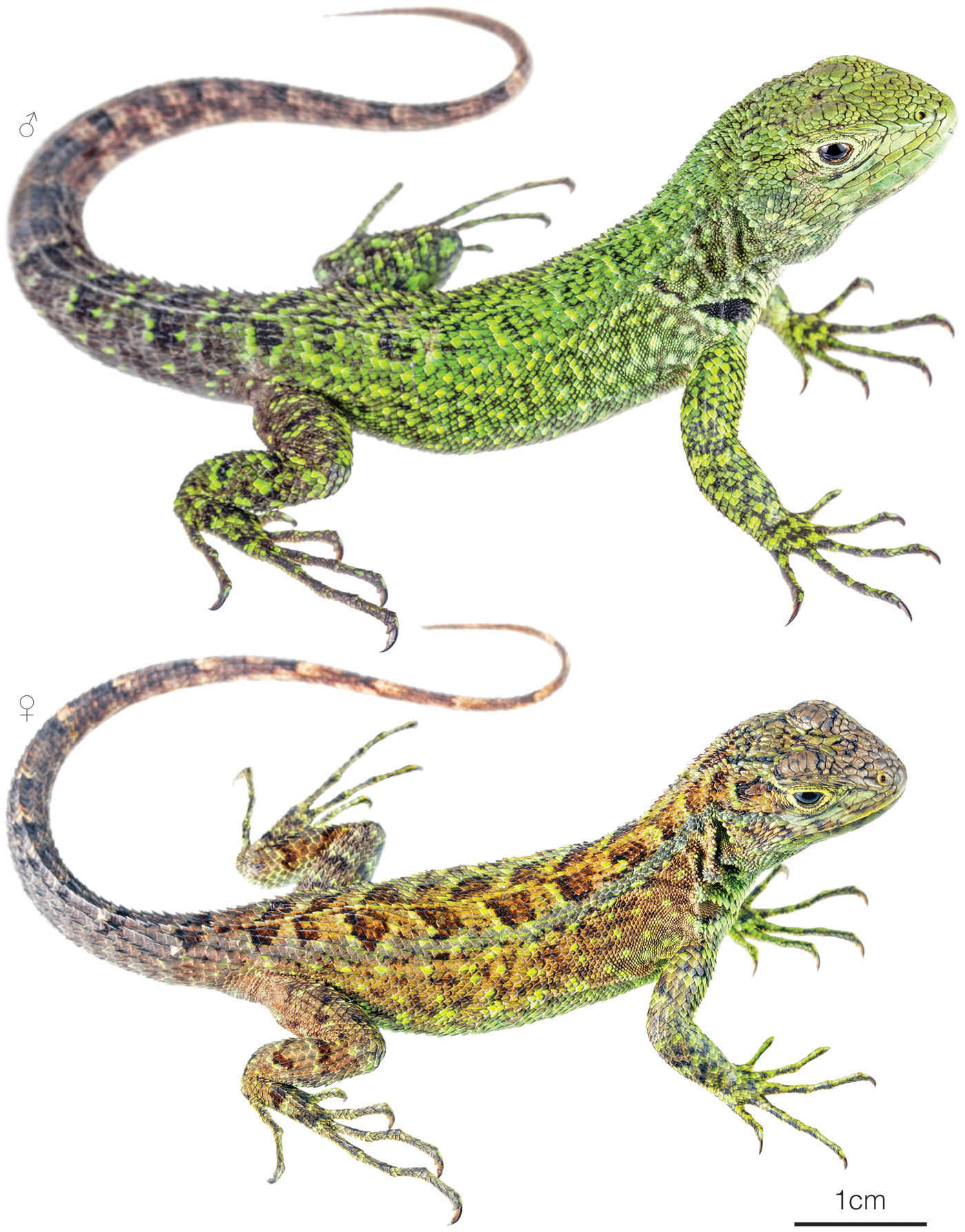Published May 16, 2021. Updated January 28, 2024. Open access. | Purchase book ❯ |
Climbing Whorltail-Iguana (Stenocercus haenschi)
Reptiles of Ecuador | Sauria | Tropiduridae | Stenocercus haenschi
English common names: Climbing Whorltail-Iguana, Haensch’s Whorltail-Iguana.
Spanish common names: Guagsa trepadora, guagsa de Balsapamba.
Recognition: ♂♂ 19.5 cmMaximum distance from the snout to the tip of the tail. Snout–vent length=7.6 cm. ♀♀ 18.8 cmMaximum distance from the snout to the tip of the tail. Snout–vent length=6.7 cm..1,2 Stenocercus haenschi can be identified from other lizards in its area of distribution by having a greenish coloration, keel-shaped dorsal scales with pointed ends, and strictly arboreal habits. Stenocercus iridescens is the only other member of the genus occurring in the same area.3 It differs from S. haenschi by having a pale brown coloration, keel-shaped and imbricate scales on the posterior surface of the thighs (granular scales in S. haenschi), and by its terrestrial habits.3 Males of S. haenschi differ from females by being more robust, having a broader head, and a bright green coloration (Fig. 1).2

Figure 1: Individuals of Stenocercus haenschi from Balzapamba, Bolívar province, Ecuador.
Natural history: Stenocercus haenschi is an extremely rare diurnal and arboreal lizard restricted to areas of evergreen foothill forest as well as pastures adjacent to these forests.1,2 Ecological observations exist for only six individuals of this species, five of which were found on trees isolated in the middle of pastures, not far from forest border.2,4 The lizards were actively moving up and down tree trunks 2–17 m above the ground, basking and foraging on branches heavily covered with spiny epiphytes, bromeliads, and moss.2 When startled, individuals took refuge in crevices, holes, and under bromeliads.2 One was found basking on rocks beside a large river during a sunny morning.4 Because S. haenschi is an extremely rare species, no more information about its natural history is known.5
Conservation: Critically Endangered Considered to be facing imminent risk of extinction..5 Stenocercus haenschi is listed in this category because the species is restricted to an extremely small (here estimated to be ~1,801 km2) area that has seen ~79% of its natural vegetation cover destroyed and replaced by pastures, crops, and human settlements.1,2,6 We estimate that, in total, there is no more than 371 km2 of forest habitat remaining for S. haenschi. This is considered to be the lizard species second closest to extinction in Ecuador. It was deemed “possibly extinct” because several surveys failed to record individuals in the type locality where it was last seen in 1899.5,7,8 As of 2021, there are only two confirmed relict populations, one 3 km from the type locality, and another 80 km south. The remaining lizards survive on isolated trees outside protected areas and under continuing pressure from deforestation.2
Distribution: Stenocercus haenschi is endemic to an estimated 1,801 km2 area in the upper drainage of the Babahoyo and Cañar rivers along the Pacific foothills of the Andes in west-central Ecuador (Fig. 2).

Figure 2: Distribution of Stenocercus haenschi in Ecuador.
Etymology: The generic name Stenocercus, which comes from the Greek words stenos (=narrow) and kerkos (=tail), refers to the laterally-compressed tail in some members of this genus, which contrasts with the dorsally flattened tail of other Tropiduridae.9 The specific epithet haenschi honors Richard Haensch, a German entomologist who explored Ecuador between 1899 and 1900 and collected individuals of the species.7,8
See it in the wild: Climbing Whorltail-Iguanas are extremely rare lizards. They are arboreal in an area where most trees have been cut down and the localities were individuals remain cannot be accessed freely. However, a visit to the type locality, Balzapamba, holds the possibility of additional sightings. The lizards may be located by carefully scanning large bromeliad-covered trees during bright sunny days.
Acknowledgments: Special thanks to María Jose Quiroz and Eric Osterman for their field assitance during the search for individuals of Stenocercus haenschi. For providing information about natural history, we are grateful to Juan Carlos Sánchez.
Special thanks to Cheryl Vogt for symbolically adopting the Climbing Whorltail-Iguana and helping bring the Reptiles of Ecuador book project to life.
Click here to adopt a species.
Authors: Amanda QuezadaaAffiliation: Tropical Herping (TH), Quito, Ecuador.,bAffiliation: Laboratorio de Herpetología, Universidad del Azuay, Cuenca, Ecuador. and Alejandro ArteagaaAffiliation: Fundación Khamai, Reserva Arlequín, Ecoruta Paseo del Quinde km 56, Santa Rosa de Mindo, Pichincha 171202, Ecuador.
Photographer: Alejandro ArteagaaAffiliation: Fundación Khamai, Reserva Arlequín, Ecoruta Paseo del Quinde km 56, Santa Rosa de Mindo, Pichincha 171202, Ecuador.
How to cite? Quezada A, Arteaga A (2024) Climbing Whorltail-Iguana (Stenocercus haenschi). In: Arteaga A, Bustamante L, Vieira J (Eds) Reptiles of Ecuador: Life in the middle of the world. Available from: www.reptilesofecuador.com. DOI: 10.47051/PERH9240
Literature cited:
- Torres-Carvajal O (2000) Ecuadorian lizards of the genus Stenocercus (Squamata: Tropiduridae). Scientific Papers Natural History Museum, The University of Kansas 15: 1–38. DOI: 10.5962/bhl.title.16286
- Field notes, Reptiles of Ecuador book project.
- Torres-Carvajal O (2007) A taxonomic revision of South American Stenocercus (Squamata: iguania) lizards. Herpetological Monographs 21: 76–178. DOI: 10.1655/06-001.1
- Field notes of Juan Carlos Sánchez.
- Cisneros-Heredia DF (2017) Stenocercus haenschi. The IUCN Red List of threatened species. Available from: www.iucnredlist.org. DOI: 10.2305/IUCN.UK.2017-2.RLTS.T178690A54447325.en
- MAE (2012) Línea base de deforestación del Ecuador continental. Ministerio del Ambiente del Ecuador, Quito, 30 pp.
- Werner F (1901) Ueber Reptilien und Batrachier aus Ecuador und Neu-Guinea. Verhandlungen der Kaiserlich-Königlichen Zoologisch-Botanischen Gesellschaft in Wien 51: 593–614. DOI: 10.5962/bhl.part.4586
- Ohaus FR (1903) Verzeichnis der von Herrn Richard Haensch in Ecuador gesammelten Ruteliden (Coleoptera lamellicornia). Berliner Entomologische Zeitschrift 48: 215–242. DOI: 10.1002/mmnd.19030480306